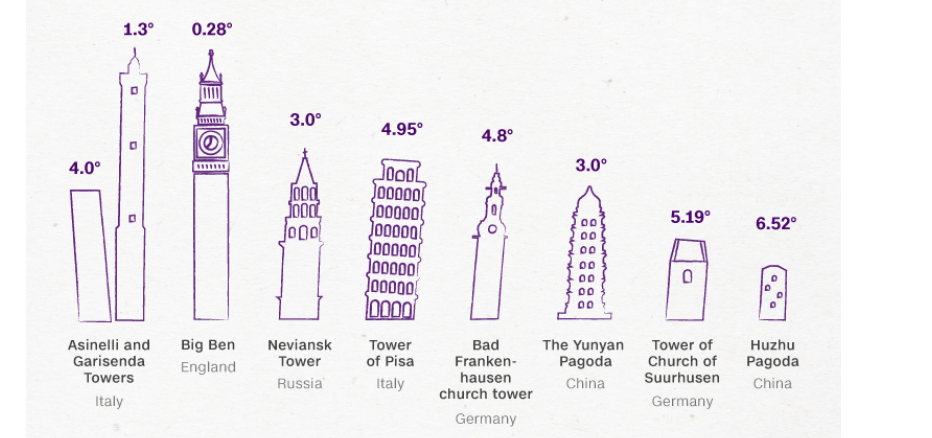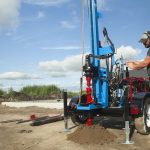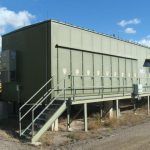A racking house is a colloquial term describing a building that leans away from its foundation. This leaning could be due to some technical or human errors. Although, in some modern buildings, it is part of the design. In this article, we explore the problems with having a racking house, review its causes in detail, and potential fixes.

Racking House Problems
A racking house, when not intentional, is a nightmare for professionals in the construction industry. Because, even if the building remains stiff with no cracks on the wall, there are additional internal forces from its eccentricity. Also, research shows that at an inclination of 20 – 25 mm/m, there is discomfort to users and equipment instability. There is likely to be drainage problems as well as lifting devices malfunction.
Another issue is leaning instability. This creates a greater problem when the slenderness ratio of the structure increases. Leaning instability occurs when the moment generated by a small increase in inclination is equal to or greater than the resisting moment in the foundation. When this occurs, it is no longer a serviceability problem that can undergo rectification work. Rather, it is judged to be a failure, leading to the demolition of the structure. Usually, this is when inclination exceeds 5%.
What Causes a Racking House
Apart from when it is an intentional design, there are certain factors that make a building to be a racking house.
Anthropogenic Factors Resulting in a Racking House
Anthropogenic factors arise from direct or indirect human activity on the soil. Typical examples are underground construction and mining explorations. Generally, such exploitation activities alter the rock mass, which eventually deforms successive rock and soil layers. Although the effect may not result in a racking house immediately, it constitutes a risk to the surrounding structures.
For example, conventional coal mining in the Upper Silesia area of Poland dating back to a century has caused strong deformations of the ground. As a result, around 12,000 buildings per year suffer from some poor mining practices. Particularly, miners prefer to pay compensation for refurbishing houses rather than using expensive hydraulic backfill to cover spaces after coal extraction.
Poor Subsoil Properties
When designing a building, it is important to take into account issues concerning the natural heterogeneity of the subsoil. Some of these include interlayering, diversification of thicknesses, and differing compressibility. Due to these inconsistencies, issues such as flooding, drought, groundwater fluctuations, and abrupt load application can lead to unexpected changes. As a result, soil bearing capacity may reduce, thus, the onset of a racking house.
A popular instance of this is the tilting of the Mexico Metropolitan Cathedral in Mexico City due to weak cohesive soil. From the completion of this cathedral in 1813, it has been gradually settling until achieving its maximum inclination in 1989. Then, it had to undergo stabilization works to minimize the inclination and prevent a reoccurrence in the future.

Foundation Problems
Foundations with insufficient depth, narrow width, and poor selection of materials are responsible for several structures becoming a racking house. For example, in some locations, the upper soil layers consist of silt, clay, and saturated sands, which are weak and compressible. So, a solid foundation in such areas, mostly pile foundations, needs to protrude into the underlain-bearing soil.
Also, increasing the width of foundations also increases its effective area, which is the soil area supporting the building’s load. Concerning poor material selection, wood is a good foundation material, but only in areas where the groundwater level is constant. As water table fluctuations would cause the wood to rot over time.
Potential Fixes
Straightening of a racking house could be a daunting task depending on the prevailing conditions. Particularly, resolving tilting problems with old buildings is difficult due to the lack of inner walls and the use of materials with low stiffness. Moreover, there is no “one solution fits all” with each structure having its unique features. However, there are three approaches usually followed when correcting a racking house.
Lifting the Lower Parts of a Racking House
Lifting up the lower part of a slanting building is a common approach and involves one of the following:
- Underpinning: This is a common way of straightening a slanting building when it is on weak and compressible soil. It involves creating a foundation that is resting on deeper and stronger strata. Then, the load transfers from the racking house to this new support. Formation of this new support involves technologies such as jet grouting, as well as drilled or pushed micro piles.
- Hydraulic Lifts: Rectifying a sloping foundation using hydraulic lifts requires significant preparatory procedures. Some of these include constructing reinforcement for the structure, chiseling out cavities and installing jacks in the load-bearing walls of the lowest floor. In addition, it is necessary to disconnect water, electricity, and any other utilities that will be affected. Then, the actual lifting process typically involves three phases. The first step is the sequential displacement of individual jacks, which rips the building apart resulting in irregular gaps between jacks. Next is a parallel lift of about an inch, so that the edges of the straightened upper part of the building and the parts remaining in the ground do not catch up in the last phase. Finally, leveling of the horizontal surface of the upper part of the building using uneven lifting occurs. On the conclusion of the lift, concrete floors should be put in the basement to the desired level. Also, walls should be plastered, and cavities due to the lift should be walled up.
Lowering the Higher Parts
This is another rectification approach that involves forcing settlement of the higher parts of the racking house. It is ideal when the foundation is on a soft soil and involves either of the following:
- Extracting the appropriate amount of soil using boreholes that could be horizontal, vertical, or at an angle.
- Loading the ground on the higher side of the structure with significant weight over a long period. This method is effective but could take several months to achieve. For example, a 600-ton ballast loading of the Tower of Pisa foundation for 10 months brought about a 10% reduction in the overturning moment.

- Reduction of the water content of fine soils to reduce their volume. The use of electro-osmosis to achieve this is common, but alternative drainage systems are also effective.
This method does not interfere with the building’s structure and works despite the number of floors. However, it increases the embedment depth and risks damage to the building during the cutting of soil layers.
Combined Method
Sometimes the rectification process combines methods that lift the lower side, as well as lower the higher side of a racking house, simultaneously. These could be a combination of any of the methods mentioned in the previous sections. An example is the “one-way lever” method. It combines raising the lower part of the building using hydraulic lifts, while lowering the higher part by soil extraction. A noteworthy application of this method was in the straightening of a 13-floor building in Rzeszów, Poland. Although effective, deploying this method should only occur when the building’s structural system lies parallel to its direction of inclination. Also, the bearing soil should not be too deep.



